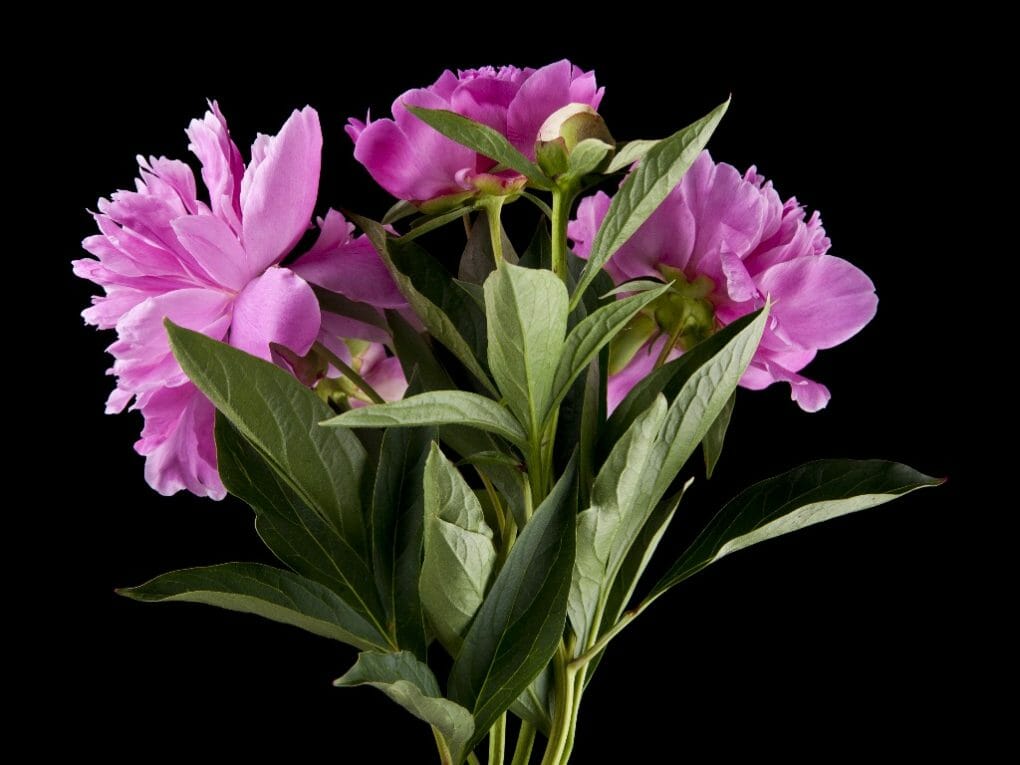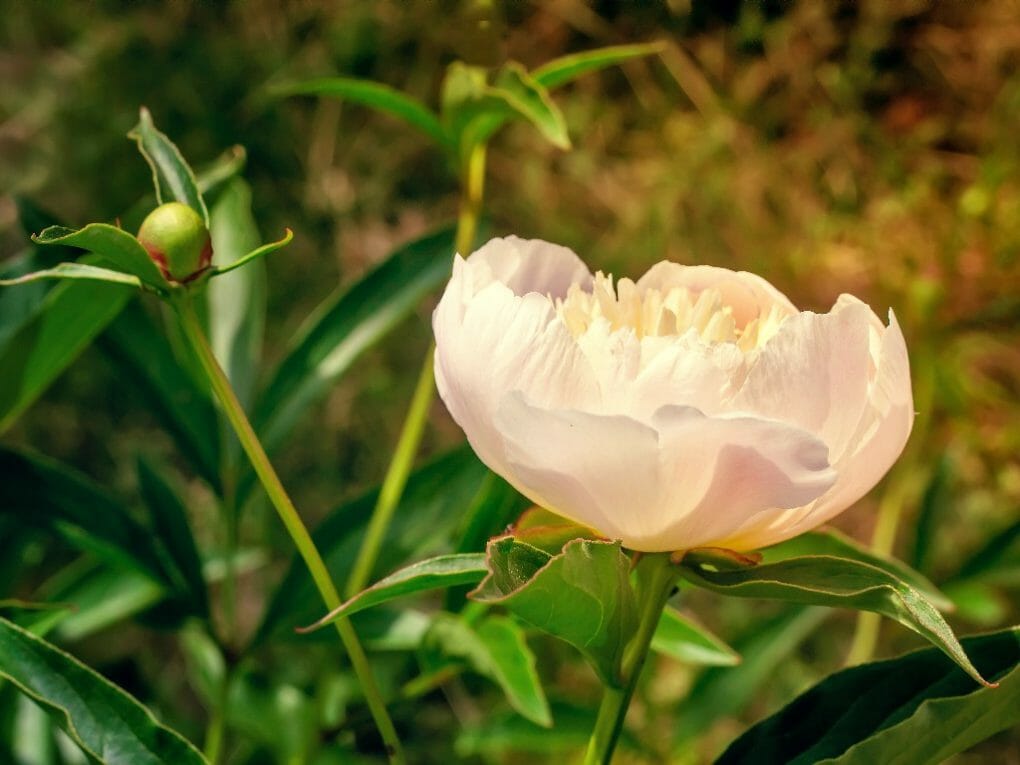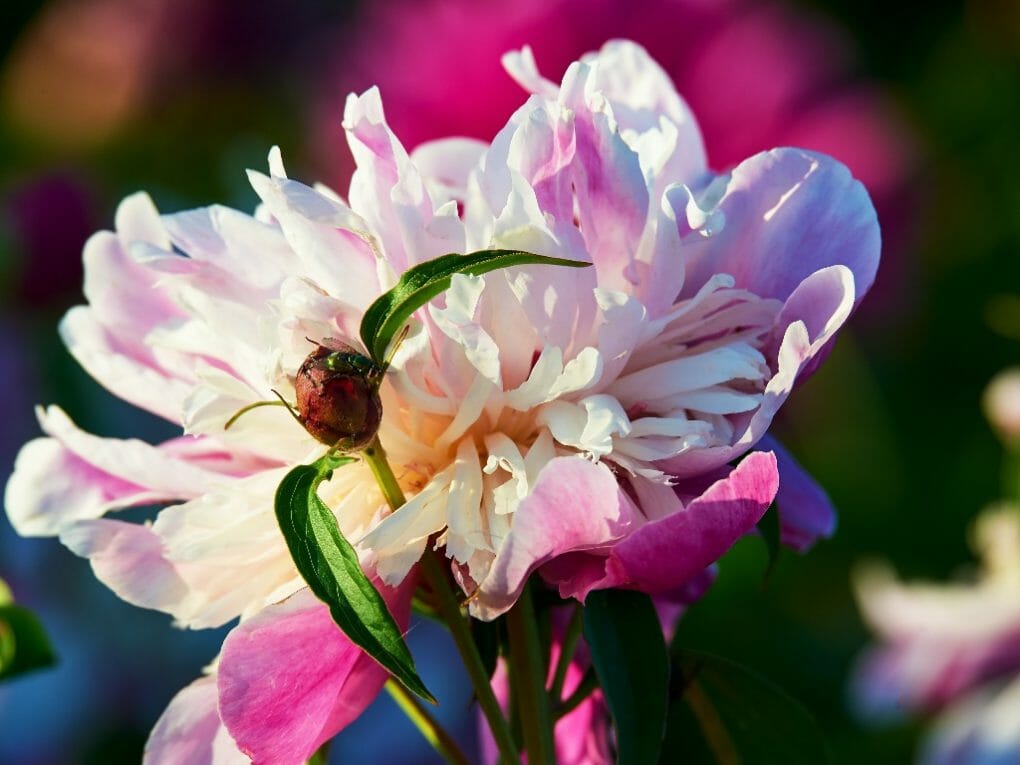Types of Peony Flowers: A Beginners Guide To Different Kinds Of Peonies

Peonies are thought to have been grown in gardens in China as early as 1000 BC. By the eighth century, they had made it to Japan, which is now a major producer of peonies. In the East, peonies were mostly used because they were good for health. Roots and seeds of the peony were often used to treat headaches and asthma and ease childbirth pain.
Explorers found tree peonies in the early 1800s and brought them to Europe for the first time. They are very popular as garden plants and cut flowers in modern times.
Table of Contents
Types of Peony Flowers
Tree Peonies
In mid to late spring, tree peonies (Paeonia suffruticosa) blossom with large, showy peony flowers. There is a striking resemblance between these flowers and those of Paeonia lactiflora, a well-known herbaceous perennial. If you enjoy peony flowers and are looking for a woody plant that provides a year-round structure above ground, tree peonies may be the perfect fit.
Tree peony shrubs can be used as a privacy screen or to restrict a space like a driveway, walkway, or property line. Usually, no more than four or five feet in height, they serve more as a visual delineator than a practical privacy screen. The green foliage of the shrubs is visually appealing even after the flowers have faded. For this reason, much of the eastern, midwestern, and western United States is ideal for these plants due to their preferred hot summers and cold winters.
Herbaceous Peonies
Hybrids of the Paeonia latiflora plant are the garden’s go-to peony. Like many other herbaceous plants, peonies die completely back to the ground each winter. White, pink, peach, red/burgundy, and lavender are all common flower colors. Herbaceous peonies come in various flower shapes and sizes, including single, semidouble, double, Japanese/Anemone, and bomb. Pollen deficiency and the number of flower petals are the defining characteristics of the various flower types. Unless supported, the massive blossoms tend to droop to the floor. Peonies are typically 2–3 feet tall when grown as a herb. In the following table, we’ve included just a sampling of the many widely-used cultivars.
Peonies, a kind of herbaceous perennial, are among the easiest plants to care for and maintain because they are resilient. A peony is extremely hardy and can easily live for 100 years or more.
These peonies are herbaceous perennials, meaning that each year they send up new stems in the spring and summer before dying back to the ground in the fall. Each year in the spring, the massive fleshy root systems, crowns, and buds come back to life and produce the beautiful flowers we have come to admire.
Herbaceous peonies, like all peonies, need to be chilled for a time to enter dormancy. Most thrive in USDA Plant Hardiness Zones 3–7, though some gardeners have successfully grown them as far south as Zone 8.
The most common herbaceous peony seen in gardens are cultivars of the Paeonia lactiflora species, which have their “roots” in China. The term “Chinese Peony” is widely used in the industry and has stuck. Wide varieties of lactiflora have a pleasant aroma and are excellent as cut flowers.
Peony hybridizers have recently begun to cross-breed different species to create hybrid peonies. The hybrids’ varied floral and vegetative traits make them versatile additions to any garden or outdoor space. P. lactiflora and the hybrids have the same cultural needs and growth habits and are grown similarly.
Itoh or Intersection Peonies
The best qualities of herbaceous and tree peonies were combined to create Itoh peonies, which have their origins in hybridization. In spite of the fact that they die back to the ground every winter and have the mounded growth habit of herbaceous peonies, these plants are capable of producing enormous flowers, just like tree peonies.
Large, up to eight inches in diameter, the flowers of the Itoh peony are surrounded by a froth of yellow stamens and encircled by undulating petals. The original Itoh cultivars were all yellow, but you can now find them in a rainbow of colors, from buttery yellow to coral red to pink to white.
Itoh hybrid peonies bloom as the herbaceous variety’s blooming period comes to a close, extending the peony season by two more glorious weeks.
The terminal buds on an Itoh peony are where the flowers begin to form. As these blooms come to a close, the side buds open.
Such a method allows a single established Itoh peony plant to produce three dozen or more blooms over a long, three-week period.
In a low, mounded form, the leaves of an Itoh peony are finely divided. Therefore, the plants themselves will continue to be the focal point of the border long after their flowers have faded.

Edmonton, California is in hardiness zone 3b, and according to a report, the cultivar ‘Garden Treasure’ is doing very well there.
On the other hand, if winter temperatures fall below -25°F, tree peony flower buds won’t make it.
Itoh hybrids are a cross between a tree peony and another variety of peonies, and they thrive in warmer climates. Ironically, the lack of cold winters makes it challenging to grow herbaceous peonies in these regions.
The Story of Itoh Peony Hybrids
The Itoh peony originated in a hybridizer’s dream: combining the best qualities of a tree and herbaceous peonies into a single plant.
Hybridizers had tried for a long time and in many places without success. The bloom times of the two peony varieties are several weeks apart, which made cross-pollination challenging.
Although both tree and herbaceous peonies belong to the massive genus Paeonia, they are not particularly related to one another genetically, which compounds the difficulty of making a cross that would result in healthy offspring.
Modern taxonomists have separated tree and herbaceous peonies into distinct sections within the larger Paeonia genus due to their distinct genetic makeups. And this is why some people refer to these new hybrids as “Intersectional” peonies.
Success beyond one’s wildest imagination. Toichi Itoh, a Japanese botanist who worked in the years following World War II’s devastation, was the first to successfully cross tree peony pollen with the ovary of herbaceous peony.
He spent excessive time and energy trying to solve the enormous hybridization problem. In 1948, he saw some of his seeds take root for the first time. It took over a decade of careful tending for those seedlings to mature into full-sized plants that bloomed. Unfortunately, Dr. Itoh passed away in 1956, only eight years after his breakthrough crossings.
His relatives tended to the unique plants until they bloomed in 1964. After obtaining permission from Dr. Itoh’s widow, American botanist Louis Smirnow brought some plants to the United States. He patented four hybrid peonies with enormous buttery yellow flowers named Itoh hybrids.
Fern-Leaf Peonies
One of the most stunning plants to bloom in spring is the peony. Peonies, a perennial flower loved for their large, delicate blooms, are also frequently used in wedding bouquets. Stunning as its flowers are, one peony species goes above and beyond the norm by boasting finely textured feathery leaves. Red, petal-packed blooms on the fern leaf peony (Paeonia tenuifolia) can grow as large as three inches across. The flowers appear to rest on the foliage because of how short their stems are. Even though you can find these plants growing wild in parts of Eastern Europe, they are underutilized in landscapes and would look great in your garden.
Fernleaf peony is hardy in USDA Plant Hardiness Zones 3–8 and prefers partial shade to full sun. Your fern leaf peony will thrive if planted in the fall. As long as the soil drains well, it can grow anywhere. No matter what kind of soil you have (sandy or clay), adding lots of compost to the planting area will help. It may be a few years before your new plant blooms, but the wait will be well worth it once the beautiful crimson petals unfurl.
Because it blooms in early spring, the fern leaf peony is sometimes referred to as the Mother’s Day peony. It takes its flowers about 7-10 days to fully bloom. Due to its shorter stems, the fern leaf peony is more successful at standing independently and rarely requires staking. As soon as the flowers have faded, cut them off to keep the plant looking its best and to allow you to appreciate the foliage for the rest of the summer.
To encourage new growth in the spring, prune your fern leaf peony completely to the ground after its leaves have died back in the fall. Your plant could use some extra compost or a little balanced fertilizer. This peony does not like to be moved around, so avoid dividing or transplanting it. Deer and rabbits avoid eating this plant, and it is rarely bothered by pests like powdery mildew or other plant-killing diseases.
Tree peonies and regular herbaceous peonies can mix to make hybrids. People often call these hybrids “Intersectional hybrids” or “Itoh peonies” (after the Japanese hybridizer Toichi Itoh). Like herbaceous peonies, Itoh peonies often die back to the ground every winter. In the spring, colorful flowers grow on top of the tree-like leaves. Both the flowers and the colors of the flowers look a lot like tree peonies. When the common herbaceous peonies start to fade, these start to bloom. Here are a few of the most well-known Itoh peonies you can buy.
Peonies are often best planted in the spring. They’re easy to find at local garden centers and often do well in pots. Peonies that grow from plants are the least expensive because they are easier to grow and spread. Fern-leaf, tree, and hybrid types are often more expensive, but the extra cost is worth it because the plants live for a long time. Most peony plants live for hundreds of years.
Peony Floral Forms

The size, shape, form, and structure of peony flowers are amazing. Peonies come in a wide range of flower shapes. Each flower shape is interesting and beautiful and makes you think. The official standard of the American Peony Society includes the Single, Japanese, Anemone, Semidouble, Bomb, and Full double forms. These have been the most common ways to group things for a long time in North America and, for the most part, Europe. The American Peony Society has ensured that this standard language stays in place to make it easier to talk about peony flowers we grow in our gardens. Other regional systems are used and written about, but APS does not use or recognize them in any official way.
Single
It usually looks like the wild form, with 5 or more petals, stamens that carry pollen, and working carpels. Singles that are grown in gardens can have up to 15 petals and still be called Singles, as long as the petals are spread out in a saucer shape and not cup-shaped, ruffled, or otherwise give the impression of a third dimension, which has been used as a reason to classify them as Semidoubles instead.
Japanese
The staminodes are what makes a flower a Japanese form. These are dead or changed stamens, but you can still tell where they came from. The edges of the staminodes are thicker, and they often have pollen that is still good, but it is wrapped up in tissue and can’t be reached any other way. The first peonies of this type came from Japan, where the fact that they didn’t drop pollen was a desirable trait.
Anemone
The stamen has changed so much in the anemone form that they now look like petals. The only visible sign that they used to be stamen is that they are yellow. These parts are called petalodes, which are the part of a flower in between the staminodes and the inner petals. Some of these petalodes are very thin and yellow, contrasting the Japanese form flower. On some, the petalodes are smaller than on others. As the size increases, the transformed segments get longer, wider, and more like the guard petals in texture and color. This leads to the Bomb flower form.
Bomb
The inner segments have grown in width and length to the point where inner petals are now almost always the same color as the guards. Overall, it looks like a ball sitting on a plate. The larger guard petals at the base of the flower make up the plate, and the inner petals make up the ball. Different Bomb form cultivars, like Red Charm and Mons, will have different-sized centers. Jules Elie is an example.
Semidouble
This name can be used for a lot of different kinds of things. They all have prominent stamens and a thickening of the petal edges. This is done in different ways, such as by turning some stamens into inner petals, making more petals, or arranging the petals to make the flower look bigger.
Full-Double
When this form is complete, all the stamens and carpels turn into petals. Still, stamens are allowed as long as they are hard to see or can’t be seen without separating the petals by hand. Peony cultivars in this group almost always have two stages (two flowers in one), probably where the term “Double” came from in traditional peony talk. Full Doubles have more petals than Half Doubles because they have two stages. If these flowers have pollen-bearing stamens, they will be in a thin ring near the edge of the lower flower and a small tuft in the middle.
